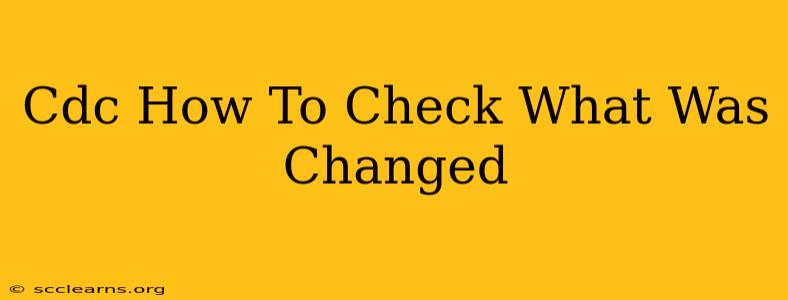The Centers for Disease Control and Prevention (CDC) website is a constantly evolving source of crucial health information. Staying updated on changes is vital for healthcare professionals, researchers, and the public alike. But how do you effectively track what's been modified on the CDC website? This guide provides several methods to monitor changes and ensure you have access to the most current information.
Understanding the Need to Track CDC Updates
The CDC website is dynamic, reflecting the ever-changing landscape of public health. New research, updated guidelines, and emerging health threats necessitate frequent revisions. Failing to track these changes could mean:
- Missing critical information: New outbreaks, updated treatment protocols, and crucial preventative measures could be overlooked.
- Using outdated data: Relying on obsolete information can lead to misinformed decisions with potentially serious consequences.
- Providing inaccurate advice: Healthcare professionals and others who disseminate CDC information need to be certain they're sharing the most up-to-date facts.
Methods for Checking CDC Website Changes
Fortunately, there are several ways to keep abreast of changes on the CDC's website. These methods range from simple visual checks to more sophisticated tracking techniques.
1. Regularly Visit Key Pages
The simplest method involves frequently visiting the specific CDC pages relevant to your needs. This is particularly useful for tracking high-priority topics. Look for updated dates prominently displayed on most CDC pages. Pay close attention to any changes in content, formatting, or the addition of new sections.
2. Utilize the CDC's Search Function
The CDC website has a powerful search function. If you're tracking a specific topic, use the search bar to revisit pages periodically. Changes to the search results themselves can indicate updates to related content. Use precise keywords to refine your searches.
3. Subscribe to CDC Email Alerts
The CDC offers email alerts and subscriptions for various health topics and announcements. This allows you to receive notifications whenever there are significant updates. Sign up for relevant alerts to ensure you don't miss crucial information. This is arguably the most effective method for staying informed on changes.
4. Monitor CDC Social Media
The CDC maintains an active presence on social media platforms like Twitter and Facebook. These platforms are frequently used to announce important updates and share links to revised information. Following their accounts allows for real-time updates on important changes.
5. Leverage Website Change Detection Tools (Advanced Users)
For more comprehensive tracking, consider using website change detection tools. These third-party services automatically monitor websites for updates and alert you to any modifications. These tools often require a subscription, but they can be invaluable for in-depth monitoring.
Best Practices for Staying Updated
- Establish a regular schedule: Make checking for CDC updates a routine part of your workflow. Whether it's daily, weekly, or monthly, consistency is key.
- Utilize multiple methods: Combining several of the methods outlined above will provide the most comprehensive coverage.
- Bookmark important pages: Save direct links to the CDC pages most relevant to you for easy access.
- Pay attention to revision dates: Always check the last reviewed or updated date displayed on pages.
By implementing these strategies, you can effectively track changes on the CDC website, ensuring you consistently have access to the most current, accurate, and vital public health information. Staying informed is critical for making well-informed decisions and contributing to public health safety.

